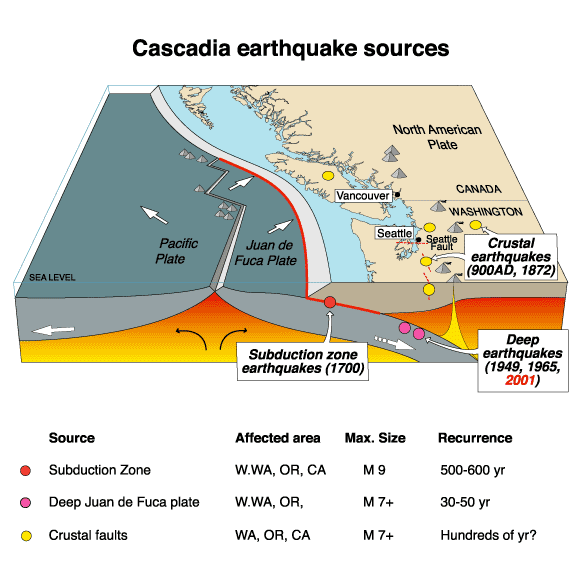How prepared are you to survive and recover from the next Cascadia Subduction Zone earthquake? Steve Robinson, of Cascadia Prepared, tells us why, when and how we should be prepared.
Steve has worked for SAIF Corporation and ODOT, was a 12-year member of the Eugene School Board, and a former lobbyist. He holds an MBA from Stanford.
Cascadia Prepared was founded in January 2017 and partners with Cascadia Region Earthquake Workgroup (CREW), Red Cross, and others. Cascadia Prepared is sponsored by OCCU, Banner Bank and SAIF among others. “We are a nonprofit organization aiming to recruit thousands of members throughout the Cascadia Region, from Northern California, through Oregon and Washington, up to British Columbia, to help us survive and thrive before, during, and after the coming earthquake.”
The Cascadia Subduction Zone is 700 miles long off the coastline of Northern California, Oregon, Washington, and British Columbia. It has an active past with over 28 severe earthquakes in the last 6000 years. There is a great risk that another severe earthquake will happen soon.
There’s an average of 202 years between quakes. The last was 319 years ago.
We’re Not Ready
We aren’t ready for the effects the coming quake will have on our economy, infrastructure, and population. There are estimates of tens of thousands of deaths from the tsunami alone. Damage and lives lost will be unfathomable.
Why Aren’t We Ready?
We only found out about this situation in the last 30 years or so. We have no personal experience with big earthquakes in our lifetime or even the lifetimes of our immediate ancestors. Building standards have tightened somewhat, but not enough. As a result, most buildings, even those built under more modern standards, will not be able to be used as shelters.
Government budgets are challenged, and because they’ve not experienced an earthquake of this magnitude, people in all walks of life are not sensitized. It’s difficult to convince people or governments that budgets should be used for preparedness when there is uncertainty about the timing. For those who fear the inevitable, it is debilitating and just carrying on with “normal” life is easier.
Lifelines At Risk
When the big one hits, infrastructure elements we depend on in order to have a viable economy will be badly damaged or even cease to exist.
Transportation: There are thousands of bridges in Oregon that are considered vulnerable and Oregon has a whole lot of liquefiable soil, which means roads, bridges, and airports everywhere will not be usable. Additionally, landslides will occur. This will result in the creation of thousands of “islands” throughout Oregon.
Utilities: Liquid fuel that powers vehicles and generators will likely end up in the Willamette River. Natural gas lines, electricity, water, and wastewater will all be broken.
Communications: With no electricity or fuel to power generators, there will be no cell phones, internet access, phone landlines. Satellite phones may continue to function for a while.
Financial Services: With no electricity, and immense property damage, we will not have access to money locally.
Housing and Shelter: Many homes will not survive, especially those built more than 30 years ago.
Critical Public Buildings: These were mostly built under inferior building codes and will not be usable.
Critical Care: There will be many injuries but most long-term care facilities and hospitals will not have the capacity or ability to care for everyone.
Food Distribution: Food will be more limited because there will not be ready for access to transportation. Existing supplies will likely be ruined. That’s why it is imperative for every family to have two weeks of food saved up.
Business: Most businesses will cease because they will not be able to survive a prolonged recovery period. As a result, the economy may shut down as all resources are poured into recovery.
Resilience Focused Priorities
Cascadia Prepared is working toward raising public awareness, creating industry groups, and providing informative tools. They are developing a resilience scorecard to help us move in a positive direction. We can all advocate for stronger public action. Prep encourages the formation of a student response corps and promote the idea of investing 1% of all resources into resilience building. We built it, we can fix it!
Getting our communities running after the quake will take years. Everything we can do now to prepare will shorten that time.
Get Your Family Ready Today
Have 2 weeks of food, water, essential supplies and go bags. Prepare your home as best you can. Create reunification and evacuation plans with loved ones – assume there will not be access to communication tools. Join Cascadia Prepared.
Get Your Workplace Ready Today
Develop a continuity plan and support policies to strengthen preparedness. Decide where you can relocate to start over. Make a plan for where you would evacuate to. It’s very likely the only asset you will have left is what you know.
Learn More about this subject through the Cascadia Prepared website, including upcoming events.
Visit Website

